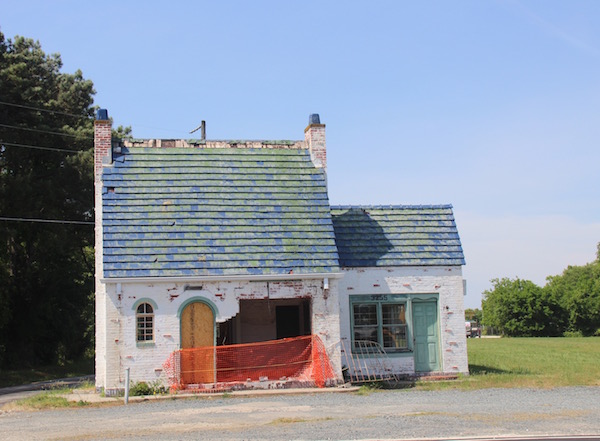#5 Story
Sad Story for Cape Charles Storybook Cottage

2008 photo by Gertraud Fendler

2015 photo by Cape Charles Wave
CAPE CHARLES WAVE
June 1, 2015
Storybook cottages became popular in the 1920s and were meant to evoke a “Hansel and Gretel” image — a gingerbread house good enough to eat. But the example on Stone Road has become a horror story, with passing years recording theft and deterioration. The former gas station has been for sale for years, but the owner reportedly has an exaggerated idea of the property’s worth. Last year someone stole the copper roof elements, and now the copper window is gone. The orange plastic screen and plywood door add little.
Gertraud Fendler created the idealized top image in 2008, available at Ellen Moore Gallery. The Wave’s bottom image is also available by special request (but not at the Gallery).
CONTINUED FROM FIRST PAGE
Last March before the most recent destruction, Jim Duffy wrote about the cottage on his webpage “Secrets of the Eastern Shore”:
Some empty buildings are just that, unfortunate bits of neglected junk on the Eastern Shore landscape. Others are something else altogether—dilapidated, perhaps, but still graced with the ability to unravel fascinating secrets behind key turns in the life of the Shore—and even the country—in days gone by.
Take this old guy, for example. He stands on the outskirts of Cape Charles, just where you are finally making your way into town from the highway. With paint peeling, weeds growing, and that tattered for-sale sign in the parking lot, the building wears a sad face.
But despite all that, it still manages somehow to announce itself as a distinctive sort of structure. And that’s exactly what it is.
To those in the know, the building marks a fascinating chapter in a revolutionary development in American life and business, the birth of the automobile. As cars became more and more popular in the early years of the 20th century, the need for gas stations grew by leaps and bounds.
But gas stations did not become popular. In fact, people generally regarded them as filthy firetraps. They didn’t want gas stations located anywhere around their homes or businesses.
The way this building was designed changed all that. The self-trained architect Carl A. Petersen came up with the concept in 1926 for the Ohio-based Pure Oil Company. The general idea was to build a safe, efficient gas station that even the neighbors could love.
Soon, just about every Pure Station around the country had this distinctive English Cottage design. Each was painted white and featured a sharply pitched roof topped with blue-enameled terra cotta. Back in the day, both chimneys would have been adorned with large “P”s. These were prefabricated buildings, made of steel and faced with brick or stucco. They were trimmed with faux shutters and cute flower boxes.
In the end, Petersen’s idea of transforming the gas station outgrew his original concept of placating neighbors. The distinctive architecture, common color scheme, and suburban design touches turned out to be a key first step for the entire oil industry toward what we would think of today as branding strategies.
Petersen’s cottages continued to be built into the 1950s. Ever since, they’ve been slowly but surely disappearing. The articles about them that I found don’t have a firm number on how many are left, but preservationists seem worried that more and more of them are disappearing. (CLICK to read full story)




















In the early to mid 1950s, my grandfather, Burleigh Griffith, would load all us grandchildren in his pickup and drive us over to “Peg’s” (this gas station pictured) for a grape or orange Nehi. It wasn’t a very long drive since he owned and worked the adjoining farm. I don’t have any idea why we called it “Peg’s”, the obvious being that it belonged to someone named Peg.
It may have been called “Peg’s” because for a time I think it was operated by Peg Lewis, of Cape Charles.
I know someone that has has has an original Pier gas station cash register that he would love to use. He is also a mason, and when he saw the brickwork he fell in love with the building and said he’d do the brick laying for a chance to use his register in the building.
My grandmother was, at one time, a short order cook at this station. I would hear the stories as a young boy, but now mostly forgotten. It’s a shame it has fallen to this state.
I have loved this building and smile every time I drive by on my way to Food Lion. I imagine many romantic ways to salvage this lovely piece of architectural history. Hopefully Robin Brownley’s friend has the opportunity to restore the brick, the fireplace, and use his Pier gas station register!